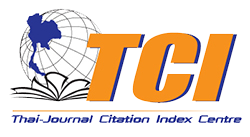การศึกษาการเพิ่มประสิทธิภาพการใชัพลังงานโดยใช้ตัวเก็บประจุยิ่งยวดด้วยการจำลองผลรถไฟฟ้าหนึ่งขบวน
A Study of Increasing Efficiency of Energy Utilization by Using Supercapacitor with a Single-train Simulation
Abstract
บทความนี้นำเสนอแนวทางการเพิ่มประสิทธิภาพเชิงพลังงานในระบบรถไฟฟ้าขนส่งมวลชน โดยการจัดการพลังงานคืนกลับจากการเบรกรถไฟฟ้าด้วยการติดตั้งตัวเก็บประจุยิ่งยวดบนขบวนรถไฟ เพื่อกักเก็บพลังงานที่ได้จากการเบรกจ่ายคืนพลังงานกลับแล้วนำไปใช้ในระบบขับเคลื่อนรถไฟอย่างเหมาะสม โดยศึกษาผลกระทบของขนาดพิกัดของตัวเก็บประจุยิ่งยวดที่ติดตั้งบนขบวนรถต่อการเปลี่ยนแปลงการใช้พลังงานของระบบ การทดสอบจะใช้ระบบรถไฟฟ้าขนส่งมวลชนกระแสตรง BTS Skytrain สายสีลม พิจารณาการเคลื่อนที่และสมรรถนะของรถไฟฟ้า 1 ขบวน ทั้งขาขึ้นและขาล่อง จากการทดสอบพบว่าการติดตั้งตัวเก็บประจุยิ่งยวดบนขบวนรถไฟฟ้าที่เหมาะสมจะทำให้ประสิทธิภาพการใช้ประโยชน์จากพลังงานที่ได้จากการเบรกจ่ายคืนพลังงานกลับสูงตามไปด้วย โดยตัวเก็บประจุยิ่งยวดขนาดไม่เกิน 15 kWh สามารถช่วยให้ประหยัดพลังงานรวมได้สูงสุดประมาณ 18 % สามารถใช้พลังงานคืนกลับได้มากกว่า 80 % และลดพลังงานสูญเสียในระบบจ่ายไฟได้สูงสุดประมาณ 44%
This article presents a guideline to enhance the efficiency of energy usage in Mass Rapid Transit Systems by means of management of regenerative energy from brake systems of an electric train using onboard supercapacitor. The onboard supercapacitors are designed to store regenerative energy and to appropriately supply energy for traction systems. The effects of capacity of onboard energy storage to energy usage of train system are studied based on the BTS Skytrain-Silom line, an urban mass transit system currently operated in Bangkok. The cases studies are performed numerically by considering a single train running along the ordinary operating route in the directions of up-track and down-track. From the numerical results, suitable capacity of supercapacitor can considerably increase the efficiency of regenerative energy usage. For energy saving purpose, a 15 kWh supercapacitor can increase energy saving rate by approximately 18%, provide regenerative energy’s recovery rate up to 80% and reduce energy losses in transmission system by 44%.
Keywords
[1] G. Xu, W. Li, K. Xu, and Z. Song, “An intelligent regenerative braking strategy for electric vehicles,” Energies, vol. 4, no. 9, pp. 1461–1477, 2011.
[2] M. Jarnut, J. Kaniewski, and V. Protsiuk, “Energy storage system for peak-power reduction of traction substation,” in Proceedings of Innovative Materials and Technologies in Electrical Engineering, Sulecin, Poland, 2018, pp. 1–5.
[3] F. Perez, A. Iovine, G. Damm, L. Galai-Dol, and P. F. Ribeiro, “Stability analysis of a DC microgrid for a smart railway station integrating renewable sources,” IEEE Transactions on Control Systems Technology, vol. 28, no. 5, pp. 1–15, 2019.
[4] C. Sumpavakup, T. Ratniyomchai, and T. Kulworawanichpong, “Optimal energy saving in DC railway system with on-board energy storage system by using peak demand cutting strategy,” Journal of Modern Transportation, vol. 25, no. 4, pp. 223–235, 2017.
[5] Q. Qin, T. Guo, F. Lin, and Z. Yang, “Energy transfer strategy for urban rail transit battery energy storage system to reduce peak power of traction substation,” IEEE Transactions on Vehicular Technology, vol. 68, no. 12, pp. 11714–11724, 2019.
[6] M. Xu, Q. Liu, C. Mao, Q. Wang and P. Sun, “Energy-efficient control of energy storage tram with signaling constraints,” in Proceedings of the 37th Chinese Control Conference, Wuhan, China, 2018, pp. 7742–7747.
[7] Y. Takeuchi, T. Ogawa, K. Sato, H. Morimoto, and T. Saito, “Optimal control method of an energy storage system for energy saving,” in Proceedings of International Power Electronics Conference, Niigata, Japan, 2018, pp. 3265–3272.
[8] S. Wei, J. Jiang, N. Murgovski, J. Sjöberg, W. Zhang, C. Zhang, and X. Hu “Optimisation of a catenary-free tramline equipped with stationary energy storage systems,” IEEE Transactions on Vehicular Technology, vol. 69, no. 3, pp. 2449–2462, 2020.
[9] H. Al-Ezee, C. Gould, and S.B. Tennakoon, “Novel method for energy management for catenary free system operation,” in Proceedings of 53rd International Universities Power Engineering Conference, Glasgow, UK, pp. 1–6, 2018.
[10] C. Wu, S. Lu, F. Xue, L. Jiang, and J. Yang, “Optimization of speed profile and energy interaction at stations for a train vehicle with on-board energy storage device,” in Proceedings of IEEE Intelligent Vehicles Symposium, Changshu, China, 2018, pp. 1–6.
[11] Y. Yoshida and S. Arai, “Charge control of regenerative power for energy saving in railway systems,” in Proceedings of IEEE International Conference on Agents, Singapore, 2018, pp. 69–74.
[12] S. Eziani and M. Ouassaid, “State of charge estimation of supercapacitor using artificial neural network for onboard railway applications,” in Proceedings of the 6th InternationalRenewable and Sustainable Energy Conference, Rabat, Morocco, 2018, pp. 1–6.
[13] C. Sumpavakup and T. Kulworawanichpong, “Multi-train movement simulation using MATLAB object-oriented programming,” Applied Mechanics and Materials, vol. 763, pp. 153–158, 2015.
[14] C. Sumpavakup, S. Suwannakijborihan, T. Ratniyomchai, and T. Kulworawanichpong, “Peak demand cutting strategy with on-board energy storage system in mass rapid transit,” Iranian Journal of Science and Technology, Transactions of Electrical Engineering, vol. 42, pp. 49–62, 2018.
[15] Bombardier Inc. EcoActive Technology-MITRAC Energy Saver. datasheet, Zurich, Switzerland, 2009.
DOI: 10.14416/j.kmutnb.2021.05.006
ISSN: 2985-2145





